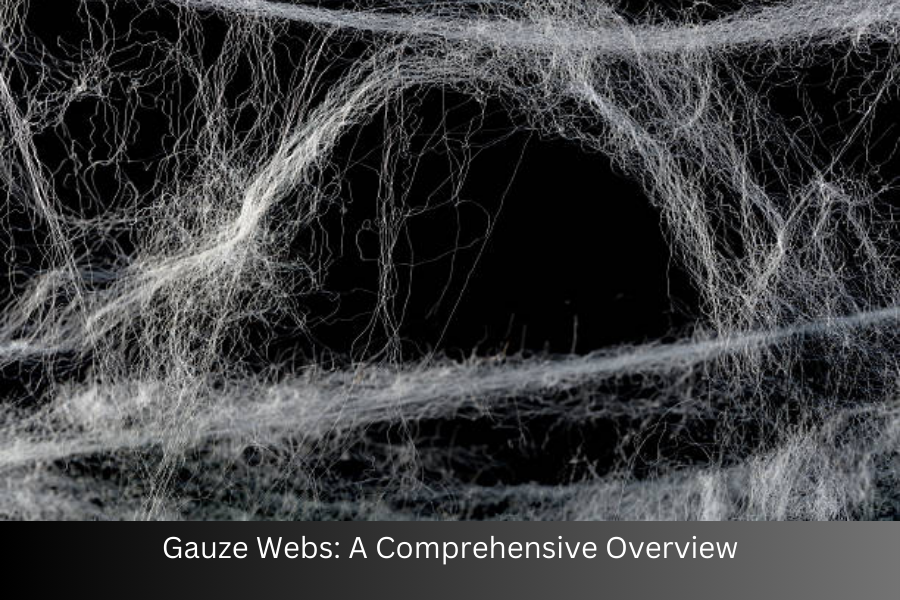Introduction
Gauze webs are often seen as a staple in medical care and crafting, yet their versatility spans across various sectors. From being used in hospitals for wound dressing to playing a crucial role in the world of DIY crafts, gauze webs offer numerous benefits. If you’re unfamiliar with them or curious about their applications, this article delves into the key details, types, features, uses, and more.
What Are Gauze Webs?
Gauze webs are thin, flexible fabrics made from a variety of materials, such as cotton, polyester, or even synthetic blends. Their characteristic open weave structure makes them lightweight, breathable, and absorbent. The open weave of gauze provides both strength and flexibility, which allows for its wide range of applications. While gauze might sound like a basic material, its versatility and utility are what make it indispensable across different industries.
The name “gauze” has its origins in Gaza, a historical city that was known for producing such fabric. Today, the term “gauze” is used broadly, encompassing all types of fabric with a loosely woven structure. Gauze webs are an extension of this fabric type, offering even greater versatility in their design.
Wiki
| Feature | Description |
| Material | Cotton, Polyester, Nylon, Synthetic Blends |
| Structure | Open weave, breathable, lightweight |
| Common Uses | Medical care (wound dressing), Crafting, Filtration, Food preparation (cheese-making, straining liquids) |
| Types | Medical Gauze, Crafting Gauze, Industrial Gauze, Cheesecloth |
| Key Characteristics | Absorbent, Flexible, Soft texture, Lightweight, Breathable |
| Sterility | Medical gauze is typically sterile; crafting gauze is non-sterile |
| Durability | Varies by material: cotton-based gauze is generally durable, synthetic gauze is stronger and resistant to wear |
| Reusability | Medical gauze is single-use, while crafting and industrial gauze can often be reused depending on the application |
| Biodegradability | Cotton-based gauze is biodegradable; synthetic gauze may not be |
| Sizes Available | Available in rolls, pads, sheets, and custom sizes |
| Color Options | Typically white, but can be dyed for crafting purposes |
| Common Industries | Healthcare, Arts & Crafts, Food Production, Industrial Manufacturing, Water Filtration, Chemical Processing |
The Different Types of Gauze Webs
Gauze webs come in a variety of forms, and each is designed for a particular application. Depending on your needs, selecting the right kind of gauze web can make a significant difference in effectiveness.
1. Medical Gauze Webs
The most common type of gauze web is the medical gauze, which is predominantly used for wound care. This gauze web is typically made from soft, sterile cotton, ensuring that it is gentle on the skin and can effectively absorb fluids. Medical gauze is available in multiple forms, such as rolls, pads, and sheets, with some designed for specific medical procedures. For instance, gauze web dressings may be used in hospitals for dressing wounds after surgeries, burns, or in cases of severe cuts and abrasions.
Medical gauze webs are often pre-sterilized to prevent infection and ensure safety. These gauze webs are highly absorbent, which is critical in absorbing excess blood or fluids from a wound. Additionally, gauze webs have air-permeable qualities, which help in keeping the wound dry, thus promoting better healing.
2. Crafting Gauze Webs
Crafters use gauze webs for various artistic and decorative purposes. Whether it’s for Halloween decorations, creating textures in paintings, or as part of a mixed-media artwork, gauze provides an elegant, airy quality to a project. Artists often use gauze webs to add depth, texture, and intricate detailing to their creations.
Gauze webs in crafting are often used as backgrounds or as a layering tool in collages. They may also be dyed to take on any color, which enhances their usefulness in the world of art. Gauze’s natural transparency and the way it interacts with other materials make it a go-to for designers and decorators seeking a soft, ethereal look.
3. Industrial Gauze Webs
Industries that require filtration, packaging, or reinforcement materials often rely on gauze webs. These types of gauze are generally made from synthetic fibers such as polyester or nylon. The material’s durability and ability to maintain its integrity over time make it useful for various applications in manufacturing processes. For example, gauze webs are used in the production of composite materials, as their open weave structure provides strength without adding excessive weight.
In filtration, gauze webs are used to remove particles from liquids and gases. This is especially common in water treatment plants, chemical processing, and other industrial environments where precise filtration is necessary.
4. Cheesecloth (A Form of Gauze Web)
A type of gauze web called cheesecloth is primarily used in the kitchen for straining liquids, particularly in the production of cheese. Cheesecloth has a finer weave than other types of gauze and is ideal for wrapping curds or straining stocks and broths. Its versatility in culinary uses extends beyond cheese-making and includes applications in preserving foods, making herbal infusions, and even separating juices from pulp.
Key Features of Gauze Webs
The remarkable versatility of gauze webs stems from several key features that distinguish them from other fabrics or materials. These features make gauze webs indispensable in various industries and applications.
1. Breathability
Gauze webs are known for their breathable quality. The open weave allows air to circulate freely, preventing the buildup of moisture, which is critical in medical settings where infections can thrive in damp environments. This makes gauze an ideal material for dressing wounds, as it promotes faster healing by allowing the wound to stay dry.
In crafting, the breathable nature of gauze can contribute to its aesthetic appeal. Whether you’re layering it for a mixed-media art piece or using it to create a lightweight draping effect, the breathable nature of gauze adds both visual and functional value.
2. Flexibility
Another remarkable characteristic of gauze webs is their flexibility. Because of their soft structure and lightness, gauze webs are highly adaptable to different shapes and contours. This flexibility is especially useful in medical settings where gauze must conform to the shape of a wound or surgical site. It’s also beneficial in industrial and crafting applications where gauze must be shaped to fit certain designs or reinforced materials.
3. Absorbency
Medical gauze webs are known for their exceptional absorbency. This feature is particularly important for controlling blood flow in wound care, where quick absorption of fluids helps to reduce the risk of infection and promotes healing. Additionally, the absorbent nature of gauze makes it useful in artistic applications for absorbing excess paint or liquids.
4. Lightweight and Soft Texture
The lightweight nature of gauze webs is one of the reasons they’re so versatile. Medical gauze does not add bulk, making it comfortable for patients. Similarly, its soft texture ensures that it won’t irritate delicate skin. In crafting, its lightness helps in creating layers without overwhelming the design or making it too heavy.
5. Durability and Strength
Despite its delicate appearance, gauze is surprisingly durable. It can hold up under considerable stress without tearing or falling apart, which is why it’s used not only in medical applications but also in industrial settings. The webbing structure of gauze gives it strength while keeping it light, making it effective as a reinforcement material in various processes.
The Various Uses of Gauze Webs
Gauze webs are not just limited to medical applications; their utility extends far beyond. Let’s take a closer look at the various fields where gauze webs are frequently used.
1. Medical Care and First Aid
The primary and most critical use of gauze webs is in medical care. Gauze is used extensively in hospitals and clinics for wound care, whether it’s for cleaning wounds, dressing injuries, or preventing infections. Their soft texture and absorbent nature make them ideal for absorbing fluids and preventing excess moisture from accumulating on the wound. In surgeries, gauze webs are essential for controlling bleeding and providing necessary post-operative care.
Sterile gauze is essential for protecting the wound from contamination and bacteria. Gauze webs are also used for applying ointments or medications to wounds, and they help with post-surgical recovery by allowing the skin to breathe while remaining protected.
2. Crafting and Decoration
In the world of arts and crafts, gauze webs are used for their decorative qualities. Whether it’s for creating textures, making Halloween costumes, or adding finishing touches to scrapbooking projects, gauze webs are integral to a variety of crafting activities. Artists may use gauze to create transparent layers, giving their artwork depth and dimension.
In DIY crafts, gauze webs can be used for creating designs in textiles, draping, or layering in home décor items. Gauze is also used to make decorations for parties and festivals, with its delicate, airy nature contributing to a whimsical, ethereal aesthetic.
3. Food Preparation
Another important use of gauze webs is in food-related applications. Cheesecloth, a finer weave version of gauze, is commonly used for straining liquids such as juices, stocks, and broths. It is also used in cheese-making to separate curds from whey, and in certain cases, it’s utilized to wrap herbs for cooking. Cheesecloth can also be used for preserving food by wrapping fruits and vegetables, allowing them to breathe and stay fresh for longer.
4. Industrial Applications
In industrial sectors, gauze webs are used in various filtration systems. From removing dust particles in air filters to refining liquids, gauze webs provide an effective and inexpensive solution for filtration. In manufacturing, gauze webs are used as reinforcement materials in composite products, thanks to their combination of strength and flexibility. These webs are often found in products like car parts, building materials, and other goods requiring lightweight yet sturdy materials.
How to Select the Right Gauze Web
When choosing a gauze web, it’s important to consider the specific use case. Here are some tips for selecting the right gauze:
1. Purpose
Understanding the intended purpose is key. Are you using gauze for medical care, crafting, or industrial work? The material and design will vary based on your needs.
2. Material
For medical use, choose cotton-based gauze or a sterile version if required. For crafts, synthetic fibers may work best as they are easy to dye and manipulate.
3. Size and Thickness
The size of the gauze web matters depending on how you plan to use it. For medical purposes, thicker gauze may be more absorbent, while thinner gauze might be ideal for light crafting tasks.
Conclusion
Gauze webs are undoubtedly versatile materials with applications that span across various industries, from medical care to arts and crafts. Their lightweight, breathable, and absorbent properties make them indispensable in both everyday medical treatments and more specialized uses like filtration in industrial settings or decorative arts. Whether you’re dressing a wound, straining cheese, or adding texture to your artwork, gauze webs offer an efficient and reliable solution.
Understanding the different types and features of gauze webs can help you select the right product for your specific needs, ensuring you get the most out of this remarkable material. Their flexibility, strength, and soft texture only add to their appeal, making gauze webs a valuable asset in many scenarios.
As you continue to explore their diverse uses, it’s clear that gauze webs are not just for the medical field but for practically any task that requires a light, durable, and breathable fabric.
FAQs about Gauze Webs
1. What is a gauze web?
A gauze web is a type of fabric with an open weave structure, usually made from cotton or synthetic materials. It is known for being lightweight, breathable, and absorbent, which makes it useful in various applications, especially in medical care, crafting, and industrial sectors.
2. What are the uses of gauze webs?
Gauze webs have a variety of uses, such as:
- Medical care: For dressing wounds, absorbing fluids, and preventing infections.
- Crafting: In arts and crafts for creating texture and adding depth to artwork.
- Filtration: In industrial settings for air or liquid filtration.
- Food preparation: In straining liquids, particularly in cheese-making.
3. What is the difference between gauze and cheesecloth?
While both gauze and cheesecloth are loosely woven fabrics, cheesecloth has a finer weave, which makes it ideal for straining liquids and making cheese. Gauze, on the other hand, is often used for medical purposes due to its softness and absorbency.
4. Can gauze webs be reused?
Medical gauze webs are typically designed for single-use to maintain sterility and prevent infection. However, non-sterile gauze webs used in crafting or industrial applications can often be reused depending on their condition.
5. Are there different types of gauze webs?
Yes, gauze webs come in different types, such as:
- Medical gauze: Used for wound dressing and post-surgical care.
- Crafting gauze: Used in art and decoration for adding texture or layering.
- Industrial gauze: Used for filtration, reinforcement, and packaging.
- Cheesecloth: A finer version of gauze used for food-related purposes like straining or wrapping curds.
6. How do I choose the right gauze web for my needs?
The right gauze web depends on its intended use. For medical purposes, ensure you choose sterile, cotton-based gauze. For crafting, synthetic gauze may be better as it’s easier to manipulate and dye. If you’re using gauze for industrial filtration or reinforcement, look for a stronger, durable material like polyester.
7. Is gauze web biodegradable?
Gauze webs made from natural fibers like cotton are biodegradable. However, those made from synthetic materials like polyester may not break down as easily in the environment. Always check the material specifications if environmental impact is a concern.
8. Can gauze webs be dyed for crafts?
Yes! Gauze webs can be easily dyed using fabric dyes, making them an ideal material for various crafting projects. Their transparency and absorbent nature allow colors to saturate the fabric beautifully, adding a unique touch to artistic creations.
Explore the latest news and updates on Play Hop



